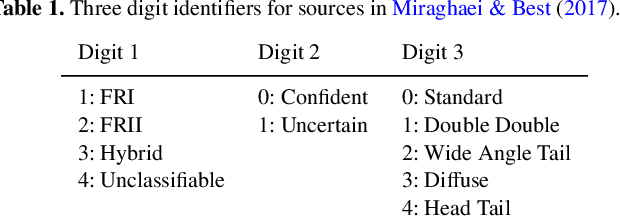Fiona Porter
A New Task: Deriving Semantic Class Targets for the Physical Sciences
Oct 27, 2022
Abstract:We define deriving semantic class targets as a novel multi-modal task. By doing so, we aim to improve classification schemes in the physical sciences which can be severely abstracted and obfuscating. We address this task for upcoming radio astronomy surveys and present the derived semantic radio galaxy morphology class targets.
Quantifying Uncertainty in Deep Learning Approaches to Radio Galaxy Classification
Jan 24, 2022



Abstract:In this work we use variational inference to quantify the degree of uncertainty in deep learning model predictions of radio galaxy classification. We show that the level of model posterior variance for individual test samples is correlated with human uncertainty when labelling radio galaxies. We explore the model performance and uncertainty calibration for different weight priors and suggest that a sparse prior produces more well-calibrated uncertainty estimates. Using the posterior distributions for individual weights, we demonstrate that we can prune 30% of the fully-connected layer weights without significant loss of performance by removing the weights with the lowest signal-to-noise ratio. A larger degree of pruning can be achieved using a Fisher information based ranking, but both pruning methods affect the uncertainty calibration for Fanaroff-Riley type I and type II radio galaxies differently. Like other work in this field, we experience a cold posterior effect, whereby the posterior must be down-weighted to achieve good predictive performance. We examine whether adapting the cost function to accommodate model misspecification can compensate for this effect, but find that it does not make a significant difference. We also examine the effect of principled data augmentation and find that this improves upon the baseline but also does not compensate for the observed effect. We interpret this as the cold posterior effect being due to the overly effective curation of our training sample leading to likelihood misspecification, and raise this as a potential issue for Bayesian deep learning approaches to radio galaxy classification in future.
Attention-gating for improved radio galaxy classification
Dec 02, 2020



Abstract:In this work we introduce attention as a state of the art mechanism for classification of radio galaxies using convolutional neural networks. We present an attention-based model that performs on par with previous classifiers while using more than 50\% fewer parameters than the next smallest classic CNN application in this field. We demonstrate quantitatively how the selection of normalisation and aggregation methods used in attention-gating can affect the output of individual models, and show that the resulting attention maps can be used to interpret the classification choices made by the model. We observe that the salient regions identified by the our model align well with the regions an expert human classifier would attend to make equivalent classifications. We show that while the selection of normalisation and aggregation may only minimally affect the performance of individual models, it can significantly affect the interpretability of the respective attention maps and by selecting a model which aligns well with how astronomers classify radio sources by eye, a user can employ the model in a more effective manner.
 Add to Chrome
Add to Chrome Add to Firefox
Add to Firefox Add to Edge
Add to Edge